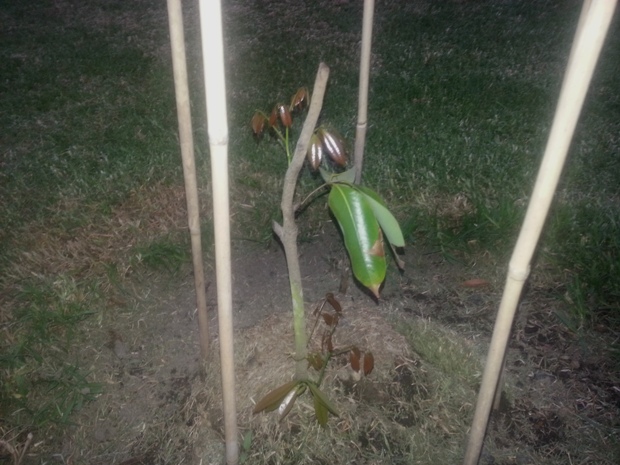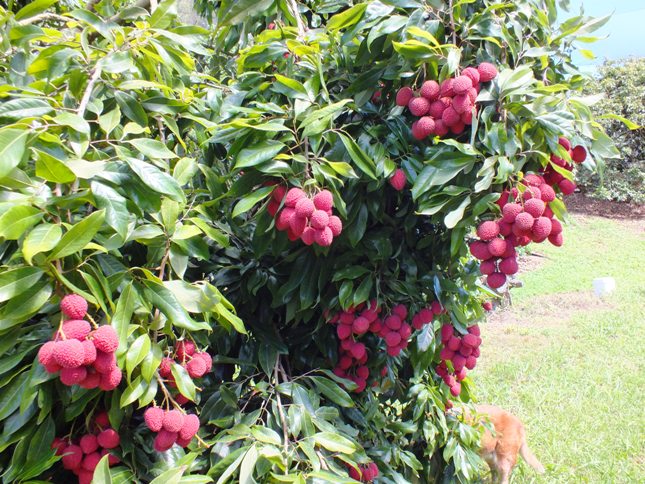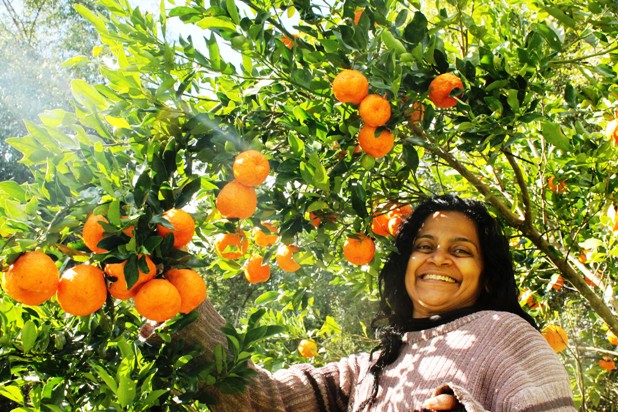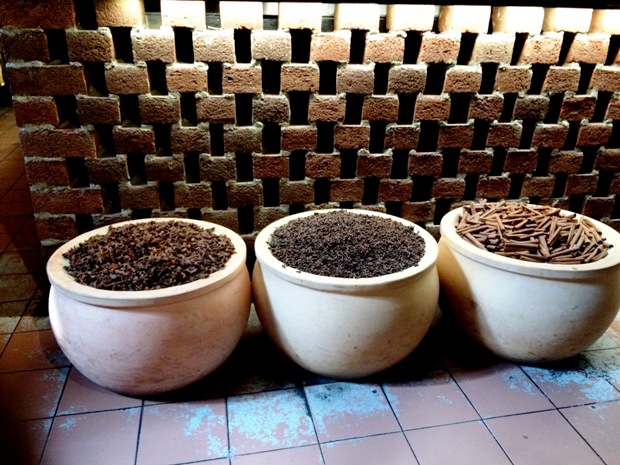Lychee season
Lychee season is here! How fortunate for me Australia has the longest lychee season in the world – producing from late October to late March.
Every time I look at my own lychee trees in the ground, I am reminded of Ted and Liz Knoblock, lychee farmers in Boambee who sold me lychee cuttings in the summer of 2014.

After nothing but only those three large leaves for about 8 months, I finally see all these new shoots
My Kwai Mae Pink lychees
In fact lychee was the topic of my very first blog post in April last year. I planted my lychee seedlings in March 2015.
What a relief to see so many more leaves on them with nothing happening for months. I learnt later that lychee can take up to 10 years to enter into full production though you can start harvesting by three to four years old. In China you can find lychee trees still producing at 200 to 300-years-old.
I had bought two different varieties. Three Kwai Mae Pink (KMP) and three Wai Chee (WC). All of the Wai Chee never made it through winter. So it was not farfetched to wonder if the KMP were still alive when I could not see any new leaves.
Ted was right. He did say it would take up to a year to see new leaves sprouting.
“I’m sorry about your Wai Chee, Shoba,” said Ted. “But the Kwai Mae Pink is a more durable specie. When we planted the older trees in 1978, they were mainly Bengal and Tai So. The Bengal has been good and is quite resistant to wind, but a lot of the Tai So were destroyed in a cyclone in 1986, so we bulldozed them and planted the then new emerging varieties of Kwai Mae Pink and Wai Chee.
“Over the years since there has been some tree losses due to disease and cyclones , in particular the Wai Chee which is not very secure in wind. Those trees have been replaced with Kwai Mae Pink and the newer Salathiel variety.”
Protecting the lychee trees
All these trees are under the canopy of strong netting which cost the Knoblocks AUD$100,000 to keep out fruit bats and rainbow lorikeets and also provide protection against a hail storm.
“We have experienced staying up all night during harvest time to chase away the bats and birds. Now the netting gives us some peace of mind,” said Ted
The Knoblocks are the southern-most lychee growers in Australia. Very few people would dare venture so far south of Queensland to grow lychee. But at an average harvest of 12 tonnes a year, they are proving that lychees can thrive in the southern climate.
it was a Chinese fruit merchant that persuaded Ted Knoblock to plant lychees in 1977, when the Department of Agriculture said it would be too cold for them at Boambee, just south of Coffs Harbour in the mid-north Coast of New South Wales.
I am further south of Coff’s Harbour, but Ted believes that lychee trees can grow as far south as Merimbula because it is a sub-tropical fruit.
Lychees need a winter of approximately 100-200 hours of chilling below 68 F (20 C)degrees before they can fruit.
So with much enthusiasm I ordered my cuttings from the Knoblocks and received them through mail. Two months later my husband Kevin and I visited their lychee farm in Boambee.
My visit to the Boambee Lychee farm
There are no words to describe the thrill of being amongst hundreds of adult lychee trees. I was like a kid in a sweet shop, but in the healthier version.
It wasn’t even the lychee season. We had just missed it having arrived in April, but there were the rogue little fellas who managed to dodge the harvesters and Liz picked them for me.
“I took some lychee from my farm to a friend who works at the local supermarket,” said Liz. “My friend decided to do a taste test between my lychee and the ones sold at the supermarket and found mine to be far more delicious.”
I agreed as the lychees at the supermarket travel longhaul in trucks to go to central distribution centres where they will sit in storage before travelling further and sitting for yet longer in cold storages for sorting and delivering to the different supermarkets.
By the time the consumer gets them they are not fresh any longer.There is no comparison to purchasing lychee directly from the farms.
With the Knoblocks farm you can even pick your own. It is open to the public during lychee season, which starts in October. They have about 500 trees over eight acres.
The Chinese connection
From the time the Chinese merchant persuaded them to choose this crop against the odds nearly 40 years ago to the present day, the Chinese have been a blessing to their farm.
Every year the Chinese flock to their farm to pick their own lychees for the Chinese New Year festival. This 2016 it is the year of the monkey and it falls on February 8.
The lychee season in Australia starts in October in Queensland where most of the lychee farms are located. However as the Knoblocks’ farm are further south in New South Wales, their harvest starts later, in January.
This works out well because it coincides perfectly with dates for Chinese New Year every year. There are traditional foods offered up during the festival with each symbolizing something. Lychees symbolize strong family ties
“The main thing we discourage people from doing while picking is pulling branches so far down that they break,” Ted explained. “They also cannot use ladders, or stand on bins etc to pick fruit because of the insurance issues. Using secateurs to pick small branches for new year is not only tolerated , but encouraged – it is free pruning for us!
“Most of the time, in picking season it is fairly damp with a low fire danger. But some years it can be quite dry at picking, and the leaves under the trees can be a fire hazard, so we don’t allow smoking in the plantation at any time. We do allow smoking on our lawn except in total fire bans so long as they do the right thing with their butts. The only other issue is rubbish left behind. Such things as discarded tissues and drink cans etc detract from the ambience of the place.
“They are welcome to leave the skins and seeds from the fruit they eat under the trees – they are good mulch.”
The rest of the lychee is sold at markets in Melbourne, Sydney and Brisbane.
It is well worth the trip to this farm in Boambee for those who want the unforgettable experience of eating fresh lychees straight off the tree. It is located at 169 South Boambee Road Coffs Harbour, NSW, 2450.
They only accept groups of at least six people and charge entry fees of $15 per head and $8 for children aged 6 and above. It is free for those under 6-years-old. In addition whatever fruit is picked is charged at market rates
During season the Boambee lychee farm will be open to visitors in the mornings from Feb 4 – Feb 21, 2016.









1 Comment
DerrickQCure · March 14, 2016 at 5:34 am
Awesome article.